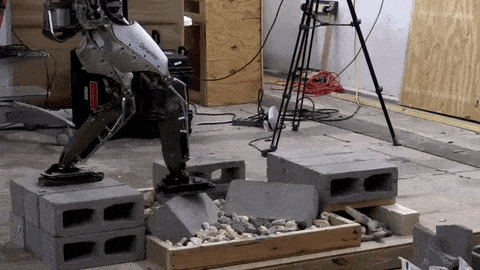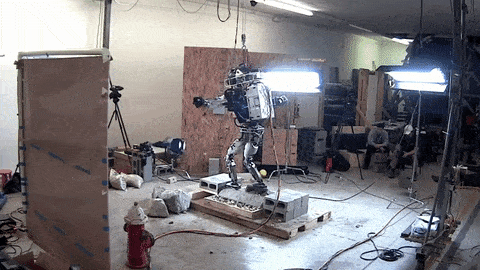This Robot Crosses Rough Ground Like a Human Does
Robots have a track record of falling over. But a new technique allows a humanoid robot to feel its way over rough ground better than ever.
In a video found by TechCrunch, researchers from the Institute for Human and Machine Cognition Robotics Lab in Pensacola, Florida, show off a new set of control algorithms that allow the Boston Dynamics robot known as Atlas to cross an uneven path of cinder blocks. It looks eerily human-like as it moves its foot to explore the ground in front of it, strides, then corrects itself by swinging its torso and arms.

In fact, that’s exactly what it’s been programmed to do. In a paper describing how the technique works, the researchers explain that “the robot explores the new contact surface by attempting to shift the center of pressure around the foot.” Then, an “available foothold is inferred by the way in which the foot rotates about contact edges ... during exploration.”
The robot uses that information to work out how it should hold its foot as it takes a step, then it moves and uses upper body angular momentum—including arm waving—to maintain and regain balance. In testing, it’s able to walk over rough surfaces that feature edges or even corners of cinder blocks.

The researchers say that their work is “an important step in the effort of making legged robots useful in real-world scenarios.” Of course, like humans, it won’t always get it right. But researchers have already started working out how to ensure that robots fall safely—so when they do take a tumble, it’s shouldn’t fracture their circuit boards.
(Read more: arXiv, “Meet Atlas, the Robot Designed to Save the Day,” “An Algorithm Helps Robots Fall Safely”)
Keep Reading
Most Popular
Large language models can do jaw-dropping things. But nobody knows exactly why.
And that's a problem. Figuring it out is one of the biggest scientific puzzles of our time and a crucial step towards controlling more powerful future models.
The problem with plug-in hybrids? Their drivers.
Plug-in hybrids are often sold as a transition to EVs, but new data from Europe shows we’re still underestimating the emissions they produce.
Google DeepMind’s new generative model makes Super Mario–like games from scratch
Genie learns how to control games by watching hours and hours of video. It could help train next-gen robots too.
How scientists traced a mysterious covid case back to six toilets
When wastewater surveillance turns into a hunt for a single infected individual, the ethics get tricky.
Stay connected
Get the latest updates from
MIT Technology Review
Discover special offers, top stories, upcoming events, and more.